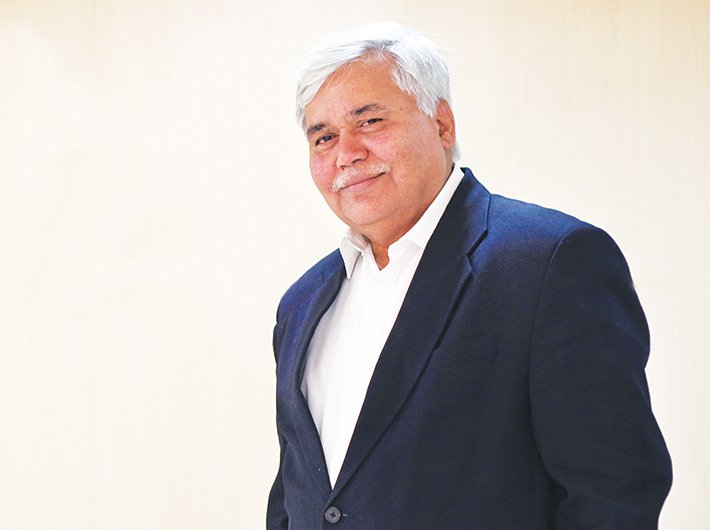TRAI chief RS Sharma talks about the various regulatory aspects of providing reliable and ubiquitous internet to the masses
In an email interaction with Pratap Vikram Singh, the TRAI chief talks about the various regulatory aspects of providing reliable and ubiquitous internet to the masses.
How will the Digital India programme succeed in absence of ubiquitous, reliable and affordable internet?
One of the three areas on which the vision of Digital India is centred is ‘digital infrastructure as a utility to every citizen’. A key component under this vision is high-speed internet as a core utility to facilitate online delivery of various services. Therefore, for Digital India to succeed, ubiquitous, reliable and affordable internet is a prerequisite. In order to expand internet access, the government has taken several initiatives to improve the digital infrastructure in the country, which are in various stages of implementation. We, at TRAI, feel that Wi-Fi coverage, especially in the rural areas, is necessary for the success of Digital India. We are likely to give our recommendation to the government on the proliferation of Wi-Fi in the country.
What all regulatory steps should be taken to ensure broadband for all, as envisaged in the national telecom policy (NTP), 2012?
TRAI, from time to time, has been making its recommendations to ensure proliferation of broadband, as envisaged in NTP 2012. In its April 17, 2015 recommendation on ‘Delivering broadband quickly: what do we need to do?’ a number of time-bound steps have been enumerated. The department of telecom (DoT) has taken a decision on some of them, like formulation of an RoW [right of way] policy, spectrum trading and spectrum sharing.
What was the reason behind TRAI’s 512 kbps definition of fixed line broadband, when the rest of the world has moved to higher speeds? Even NTP, 2012 provides for 2 mbps speed by 2017. In its previous documents, the TRAI had admitted minimum broadband speed of 2 mbps.
The rationale behind these recommendations was that setting a very high-speed for broadband right away might affect its affordability, especially for the rural people, who would be the major consumers of broadband in the coming years. Further, the network required for supporting high-speed broadband needs to be put in place in most parts of the country before enhancing the speed. TRAI in its May 24, 2016 recommendations had again recommended that the current definition of broadband in the country be reviewed and minimum download speed be increased to 2 mbps.
Since 2004 TRAI has been recommending for greater broadband access. Several consultations have happened. What have been the biggest challenges and outcomes so far?
It is a fact that several rounds of consultations have been held and policy measures devised and suggested. The biggest challenge has of course been planning and executing these ideas on ground.
To increase internet adoption, you have also recommended universal access to ‘free data’ and a platform-based approach for cheap internet access. What has been the response from DoT and the industry?
The introduction of schemes for the provision of free data services into the Indian telecom market would create benefits in terms of greater digital inclusion, increased spend on telecommunication services and innovation in content and services. The recommendations have been made as a result of TRAI consultation process. So, we should assume that it is the general view of the industry also. As for the response of DoT, the outcome is awaited.
Why don’t we define wireless broadband? What is the grievance redressal mechanism for consumers facing problem with poor internet?
Due to the laws of physics, there are constraints to exactly measure or provide specified wireless data speed to consumers. However, we are in consultation with service providers to find a solution which could best meet the interest of subscribers.
Can you explain the use of cable TV infrastructure in delivering internet? Can it be used to offer high speed and reliable internet?
The digitisation of the cable TV network has opened up a new avenue of providing broadband. One of the objectives of digitisation of cable TV network was to free the bandwidth available in the co-axial cable, which can be utilised for providing broadband services. Cable TV networks can be an economical, convenient and faster way of providing wire line broadband, as they already have access to over 100 million households. This will also improve the business model and efficiency of cable TV networks. The NTP 2012 provides facilitation of convergence of local cable TV networks post digitisation. Cable operators can deploy cable modem or fibre-based technologies as per their business plans to deliver high-speed broadband to users.
You don’t support the telecom department’s position on white space technology. Why is that?
TRAI is yet to examine the issues and take a position on this matter.
Is over dependence on wireless – the way it is in the Indian telecom sector – a problem in providing ubiquitous broadband for all? What are the alternatives?
Over dependence on wireless has been a case in all developing economies. According to the ITU [International Telecommunication Union] estimates, by the end of 2016, the mobile cellular connections were likely to reach 7.4 billion as against just 884 million fixed broadband subscriptions. This is primarily because of less investment and effort required for providing a wireless connection vis-a-vis a fixed line one. Provision of broadband through cable network is an alternative that needs to be encouraged.
Are you hopeful that BharatNet project will meet its revised deadline this time? The second phase, which is yet to be approved by the cabinet, talks of industry participation.
The government is pushing for faster implementation of the project. We should be hopeful of achievement of the stated targets.
Is the Universal Service Obligation Fund (USOF) and BharatNet the best way to give rural India access to internet?
BharatNet is the vehicle for the attainment of Digital India vision. According to an ITU report, countries that included public investment in backbone and aggregation in national broadband plans (NBP) have seen prices drop by four percent of gross national income (GNI) per capita in four years versus one percent for countries that had not invested. TRAI has issued a recommendation, ‘Recommendations on implementation strategy for BharatNet’. We feel that business interest of the implementing agency is very important in any project. Early utilisation and monetisation of BharatNet is the key.
Studies show that poor access to internet and broadband is partly because internet is irrelevant for a large size of the population. There is hardly any content in regional languages. Affordability is another challenge. How can we overcome these?
Besides building and providing the necessary infrastructure and ecosystem, content is the key to proliferation of broadband use. Content is the currency of the internet; better content means high visibility, more visitors, and results in increased revenue. Therefore, relevant and local content is the strongest vehicle to increase broadband demand. To build a robust ecosystem for broadband penetration, affordable devices, relevant content and the delivery of government and public services through specific applications, is of even greater importance. Demand creation for a product is as important as creation of supply.
(The interview appears in the March 1-15, 2017 issue of Governance Now)



